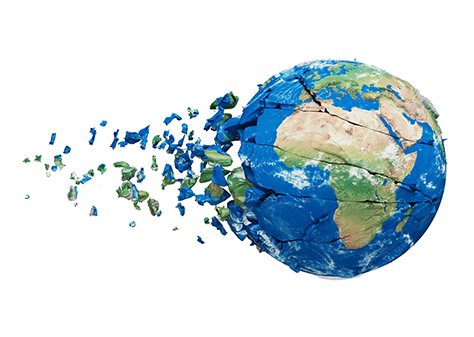
Reinventing Resilience
Ever since the World Health Organization declared the outbreak of coronavirus a pandemic in March 2020, the world has been ruled by uncertainty. More than two years later, as we learn to live with the virus and continue to take measures to prevent its resurgence, fresh challenges are emerging, and supply chains are at the epicentre of the fallout.
This month, the World Economic Forum (WEF), the international organisation for public-private cooperation, in collaboration with McKinsey & Company, announced the launch of a Resilience Consortium, a new public-private leadership effort to drive global resilience. The consortium is bringing together leaders from the public and private sectors who are committed to advancing resilience globally – across regions, economies and industries. The aim is to develop a shared, comprehensive view of resilience and its drivers to help policymakers and business leaders recognise the opportunities, and lay the foundations of sustainable and inclusive, long-term global growth.
The United Nations, the World Economic Forum, McKinsey Global Institute, the International Monetary Fund and other leading organisations estimate that a significant share of annual GDP growth will depend on the degree to which organisations and societies develop resilience. Growth differentials of between 1% and 5% globally can be expected depending on how leaders respond to the many challenges, including climate change, the energy transition, supply chain disruptions, healthcare availability, and income, gender and racial inequalities, WEF says.
Seven key drivers of resilience
To coincide with the announcement of the Resilience Consortium, on 20 May, WEF ad KPMG published a new white paper on ‘Resilience for Sustainable, Inclusive Growth’, outlining seven key drivers of resilience, which have fundamental, cross-cutting business, economic and societal implications:
- Climate Food and energy
- People, education and organisations
- Healthcare
- Sustainable economic development
- Trade and the supply chain
- Digital trust and inclusion
- Finance and risk.
The white paper states: “COVID-19, climate change and, most recently, the war in Ukraine and the ensuing refugee crisis, are the latest reminders of the unprecedented capacity of external shocks to disrupt economies and societies. In a world of continuous, overlapping disruptions, organisations need to build and manage resilience to secure a sustainable, inclusive future for all.”
Assessing trade and the supply chain, the white paper states: “Global economic interdependencies have deepened for decades, resulting in a steep incline in world trade volumes. Globalized production and supply, aided by many free trade agreements concluded in the late-20th and early-21st centuries, allowed economies and businesses to develop strong international relationships. “While limits to these new relationships were posed by geopolitical friction, the COVID-19 pandemic revealed other vulnerabilities. As borders were closed and mobility was restricted in efforts to control the spread of the virus, supply chains were disrupted, often radically.”
Supply chains continue to struggle
The white paper continues: “Customer demand experienced some volatility, but with shifts (such as the accelerating use of digital channels), it soon recovered. Supply chains, however, continue to struggle. Just-in-time practices, used in many sectors to minimise waste by keeping supply inventories low, were put to the test. Limited stocks were quickly exhausted. In response, manufacturers improvised. Some established dedicated teams to develop supply and demand intelligence, combining data on the supply chain and supplier commitments. Some began to reconsider, at least in part, just-in-time delivery and maintenance of low stock levels along their value chains.
“Some governments, concerned about dependence on single suppliers and distant countries for vital needs, began to push for more regional and diverse sourcing. The effects of the present pandemic-related supply shocks will continue to appear as a result of trade policy changes, workforce scarcity and inflation. While there is no such thing as a disruption-proof supply chain, governments and companies can cooperatively work towards a flexible design. The solutions will likely combine several elements: a limited just-in-case approach with redesigned inventory holding; an expanded supply base, including diverse regions and routes; vertical integration where appropriate; and radical transparency across supplier tiers and new operating models and partnerships.” It adds that governments have a vital role to play in establishing connections across segregated data, using accelerated regulatory approvals to advance adoption and innovation, such as 3D printing for flexible production close to point of use. Collaboration and coordination by the public and private sectors is needed to target investment and avoid duplication of effort.
Delegates attending TAPA EMEA’s supply chain security and resilience conference in Amsterdam on 7 & 8 June will no doubt have been party to such discussions within their own organisations, to a greater or lesser extent. These are topics of conversation which are unlikely to go away. This is the ‘new normal’ or at least the trending outcomes of the lessons of the past two years.
Throughout international lockdowns, supply chains, and the people keeping them moving, have been heralded for critical deliveries of PPE, vaccines and for ensuring there was food of the shelves in stores across the globe. Ecommerce volumes soared. In 2021, online retail sales hit $4.9 trillion. The market is now forecast to grow by 50% over the next four years to $7.4trn by 2025.
But for all these heroic actions, supply chains are under more intense pressure and scrutiny than the industry’s leaders can ever recall. Unprecedented labour shortages at ports, airports, in warehouses and fulfilment and distribution centres are bringing productivity and cost pressures like never before, adding to the decade-old decline in the driver workforce. Fuel prices have peaked while the ‘cost of living crisis’ throws a new hand grenade of uncertain into the demand versus supply equation. Both are stimulating ‘black market’ activities and new and growing sources of income for Organised Crime Groups which thrive on the back of uncertainty. Consequently, the crime risks for supply chains are fully expected to go on increasing, and the upward curve may well accelerate at a faster pace for the foreseeable future.
An urgent need for collective action
Announcing their plans for the Resilience Consortium, Børge Brende, President of the World Economic Forum,said: “Building greater resilience has become a defining mandate for this generation. The war in Ukraine is having a devastating impact not only on the people of the region but also knock-on effects on global commodity prices that may cause political and humanitarian crises in other parts of the world. There is an urgent need for more collective action and coordination by the public and private sectors to mitigate risks and sustain growth against disruptive shocks, especially among the most vulnerable populations. Policy decisions and financial commitments made today will determine the future course of the planet, economies and societies. Now is the time for action.”
He is not alone in this thinking. Bob Sternfels, Global Managing Partner of McKinsey & Company, added: “Our research shows two things: 1) failure to invest in resilience is costly and far exceeds the cost of weather proofing ahead of disruptions; and 2) resilient organizations outperform non-resilients before, during and after crisis. We are convinced that public and private sector organizations must take a new approach developing resilience that goes beyond defensive stances. In light of today’s increased economic volatility, fundamental environmental and societal challenges, and continuous disruptions, the time is now to build resilience as a strategic muscle.”
The ‘Resilience for Sustainable, Inclusive Growth’ white paper is available to DOWNLOAD here.






















